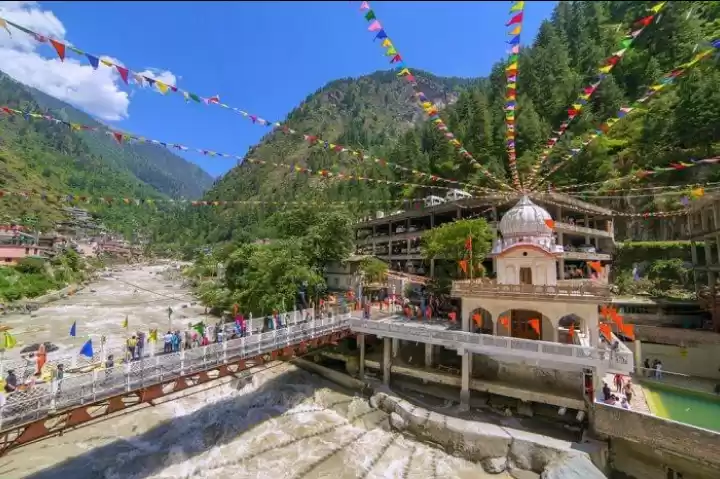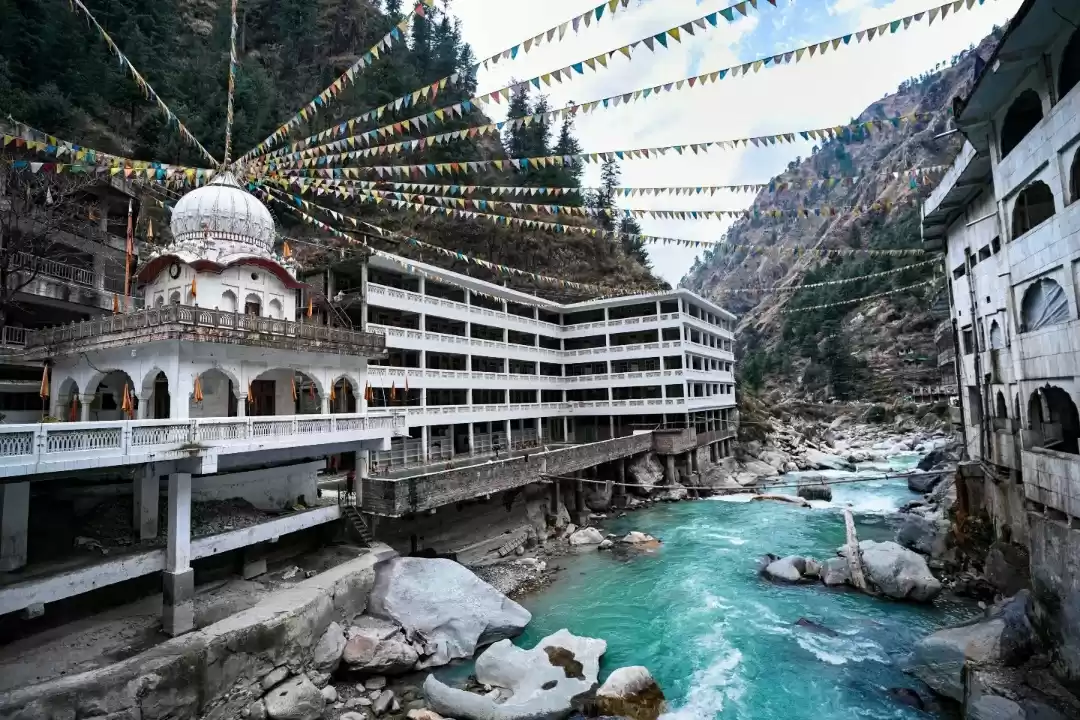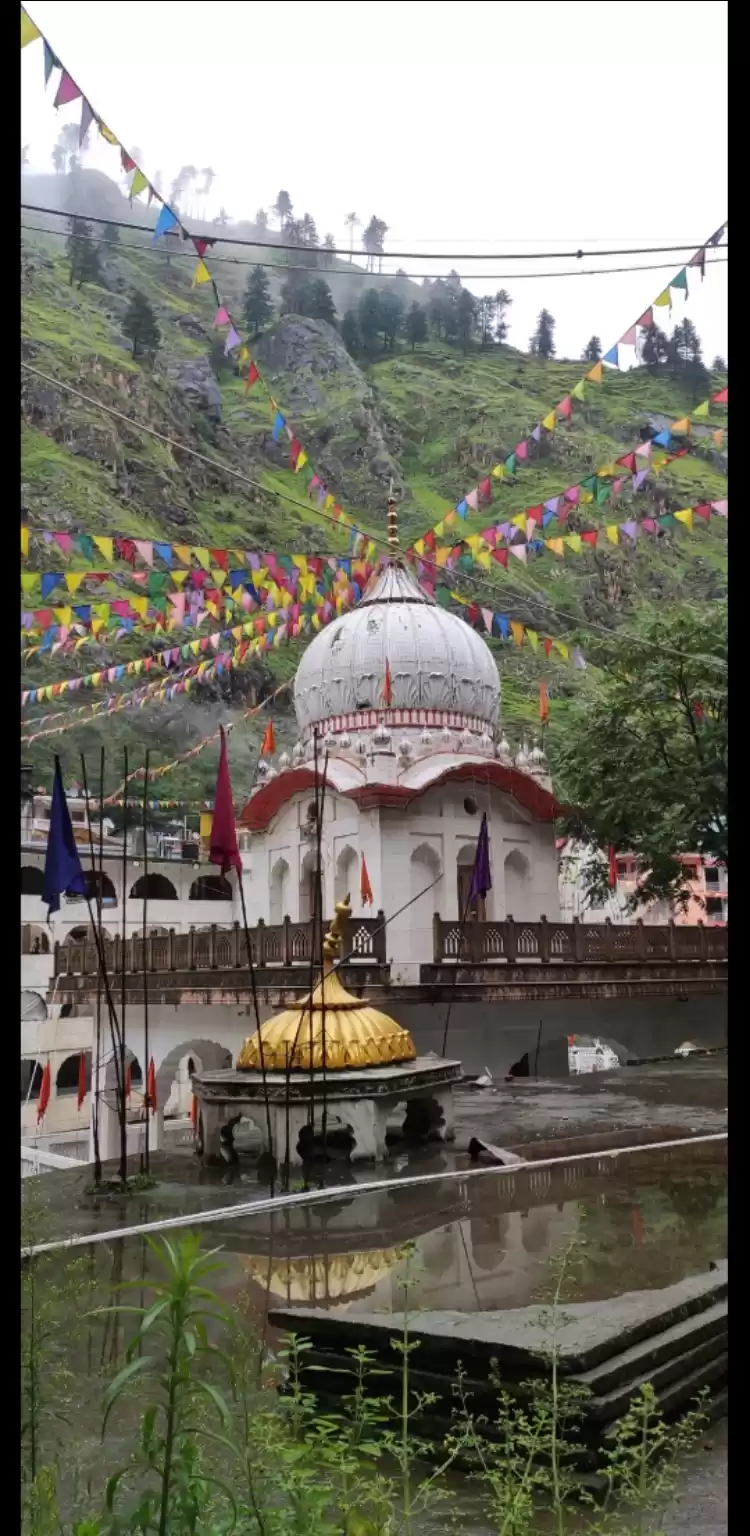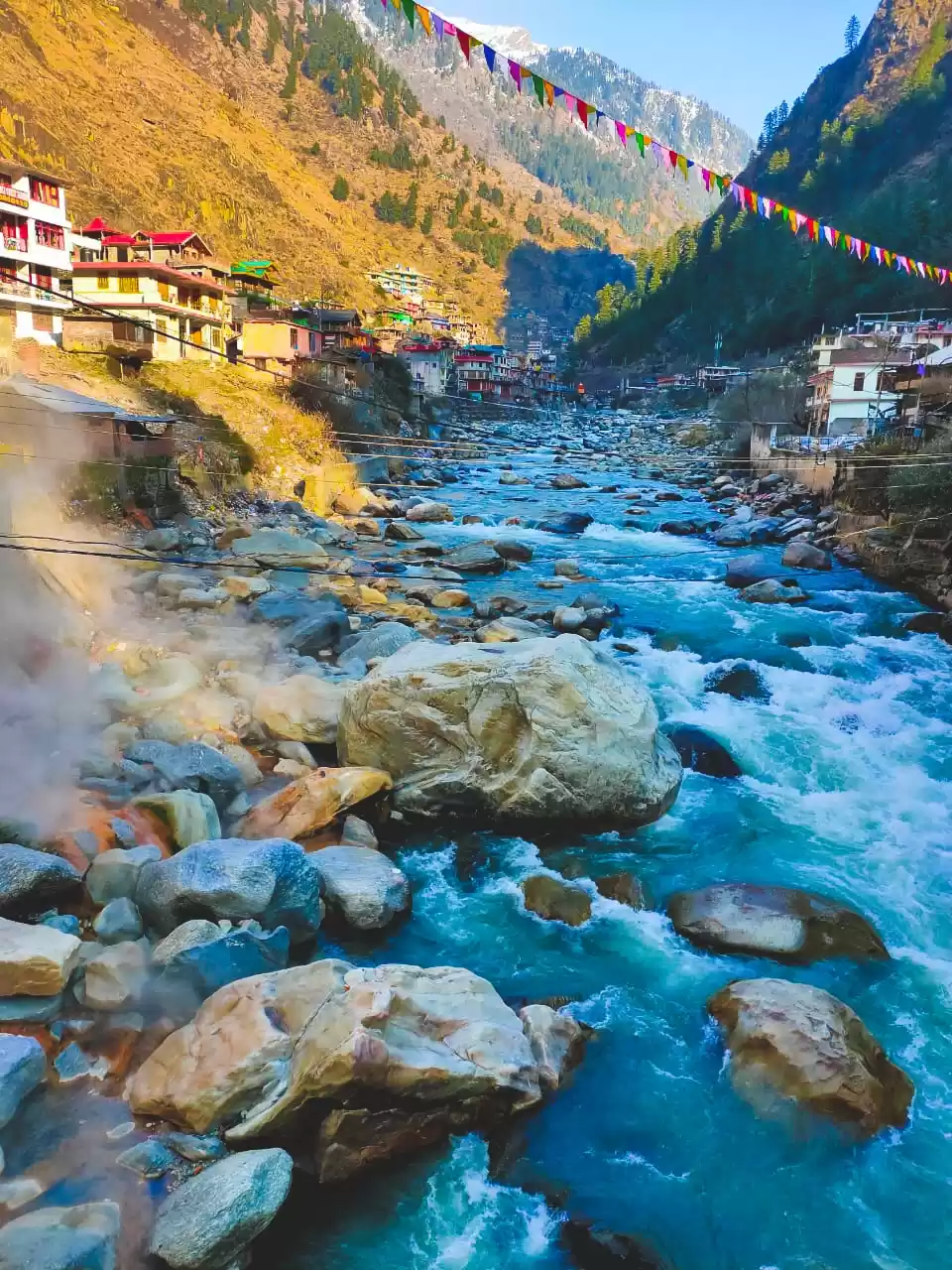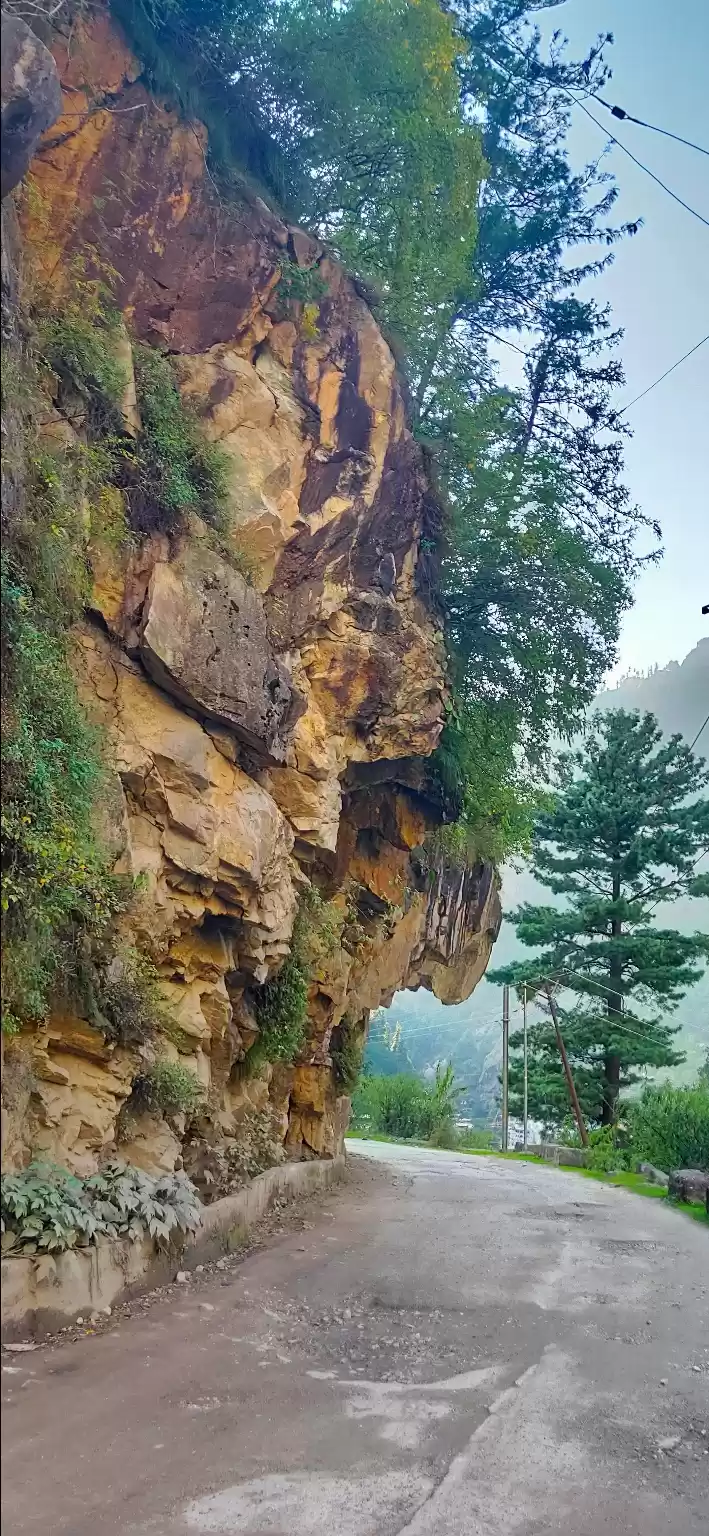Have you ever wondered what it would be like to visit a place where you can witness the miracles of nature and faith? A place where you can enjoy the beauty of the mountains, forests, and river, while also experiencing the culture and spirituality of two major religions? A place where you can relax in the healing hot springs, savor the delicious langar, and explore the nearby treks and villages?
If you are looking for such a place, then Manikaran Sahib is the perfect destination for you. Manikaran Sahib is a gurudwara (Sikh temple) and a pilgrimage center for Hindus and Sikhs in Kasol, Himachal Pradesh. It is located on the banks of the Parvati River, about 5 km away from Kasol.
It is believed to be the place where Guru Nanak, the founder of Sikhism, performed several miracles and preached his teachings . It is also a place where Lord Shiva and Goddess Parvati lost and recovered their precious jewels (manis) in the river.
By the end of this article, you will be ready to plan your trip to this sacred and scenic destination.
Manikaran Sahib: A Place of Miracles and Mysteries
Manikaran Sahib is not just a gurudwara or a temple. It is a place where you can witness the miracles and mysteries of nature and faith. According to legend, Manikaran was visited by Guru Nanak in 1574 along with his disciples Bhai Bala and Bhai Mardana . They were hungry and wanted to cook some food, but they had no fire or utensils.
Guru Nanak asked Bhai Mardana to collect some stones from the river. To their surprise, they found that the stones were hot and could be used to cook food. They also found that the water in the river was boiling due to the hot springs .

Guru Nanak then explained that this was a divine gift from God, and that anyone who bathes in this water or eats this food will be blessed with health and happiness . He also preached his teachings of one God, equality, service, and justice to the people of Manikaran. He built a gurudwara there to commemorate his visit .
Manikaran is also a pilgrimage center for Hindus, as it has many temples dedicated to Lord Shiva, Lord Rama, Lord Vishnu, and Lord Krishna .
According to another legend, Manikaran was the place where Lord Shiva and Goddess Parvati spent some time during their honeymoon. One day, Parvati lost her earrings (manis) in the river. She asked Shiva to find them, but he could not. He became angry and opened his third eye, causing a huge disturbance in the universe.
The serpent god Sheshnag heard their plight and offered to help. He hissed loudly, causing the earth to shake and release hot water and gas from below. The earrings came out of the water along with many other jewels. Shiva and Parvati were happy and blessed Manikaran with their presence.
Some of the main attractions and features of Manikaran Sahib are:
Gurudwara Manikaran Sahib: The Abode of Guru Nanak
This is the main attraction of Manikaran Sahib. It is a beautiful white building with a golden dome that stands on the bank of the Parvati River . It houses a sacred pool (sarovar) that is fed by the hot springs. The water in the pool is so hot that it can boil rice and vegetables in minutes.
The gurudwara offers free langar (community meal) to the visitors, which is prepared using the hot spring water. The langar is served round-the-clock and the gurudwara also provides free accommodation to the visitors, who can stay in the dormitories or rooms. The gurudwara is open throughout the year for worship and accommodation.
Also check out: Manikaran Sahib: A Sacred Town Of Confluence of Faith
Temples of Manikaran: The Legacy of Lord Shiva and Goddess Parvati
Manikaran Sahib is also home to many Hindu temples that are dedicated to various gods and goddesses. The most prominent ones are:

Shiva Mandir Manikaran:
This is the oldest temple in Manikaran, dating back to the 16th century. It is believed to be the place where Lord Shiva and Goddess Parvati stayed during their honeymoon. The temple has a beautiful idol of Shiva and Parvati, along with a silver-plated lingam (symbol of Shiva). The temple also has a hot spring inside, where devotees can take a dip and offer prayers.
Ram Mandir Manikaran:
This is another ancient temple in Manikaran, built by Raja Jagat Singh of Kullu in the 17th century. It is dedicated to Lord Rama, his wife Sita, and his brother Lakshman. According to legend, Lord Rama visited Manikaran during his exile and performed a yagna (fire ritual) here. The temple has a beautiful idol of Rama, Sita, and Lakshman, along with a stone that is believed to be the remains of the yagna fire.
Vishnu Mandir Manikaran:
This is a relatively new temple in Manikaran, built in the 19th century. It is dedicated to Lord Vishnu, the preserver of the universe. The temple has a stunning idol of Vishnu, along with his consort Lakshmi and his vehicle Garuda. The temple also has a hot spring inside, where devotees can take a bath and offer prayers.
Krishna Mandir Manikaran:
This is another new temple in Manikaran, built in the 20th century. It is dedicated to Lord Krishna, the avatar of Vishnu and the hero of the Mahabharata. The temple has a magnificent idol of Krishna, along with his beloved Radha and his flute. The temple also has a hot spring inside, where devotees can take a bath and offer prayers.
Hot Springs of Manikaran: The Source of Healing and Cooking
One of the most fascinating features of Manikaran Sahib is its hot springs. There are several hot springs in and around Manikaran Sahib, which are considered to have healing properties and are used for cooking food and bathing.
The water in the springs is rich in minerals like sulphur, uranium, potassium, etc., which are said to cure various skin diseases, rheumatism, arthritis, etc. . The temperature of the water varies from 35°C to 97°C depending on the location and depth of the spring . Some of the popular hot springs are:

Gurudwara Sarovar: This is the sacred pool inside the gurudwara that is fed by the hot springs. The water in the pool is so hot that it can boil rice and vegetables in minutes. The gurudwara uses this water to prepare langar for the visitors. The pool is also used for bathing by the devotees who believe that it will wash away their sins and diseases .
Shiva Temple Spring: This is the hot spring inside the Shiva Temple that is used for bathing by the Hindu devotees. The water in this spring is also very hot and has a strong smell of sulphur. The devotees believe that bathing in this water will please Lord Shiva and Goddess Parvati and grant them their wishes.
Kulant Pith Spring: This is another hot spring near Manikaran Sahib that is considered to be very powerful and sacred. It is believed that this spring was created by Lord Shiva himself when he opened his third eye. The water in this spring is so hot that it can melt iron. The devotees believe that bathing in this water will remove all their troubles and obstacles .
Langar of Manikaran: The Symbol of Service and Equality
One of the most amazing aspects of Manikaran Sahib is its langar service. Langar is a free community meal that is offered to everyone regardless of their religion, caste, gender, or status. It is a way of expressing the Sikh values of service, equality, and generosity. The langar at Manikaran Sahib is prepared using the hot spring water and served round-the-clock to the visitors.
The langar consists of simple but tasty dishes like dal (lentil soup), roti (flatbread), sabzi (vegetable curry), and kheer (rice pudding). The langar is served by the volunteers who also help in cooking, cleaning, and managing the gurudwara. The langar is not only a source of food, but also a source of joy and harmony for the people who share it.

Accommodation in Manikaran: The Option of Staying Overnight
If you want to spend more time in Manikaran Sahib and experience its peaceful and spiritual atmosphere, you can opt for staying overnight at the gurudwara or the temples. The gurudwara and the temples provide free accommodation to the visitors, who can stay in the dormitories or rooms. The rooms are basic but clean and comfortable, with attached bathrooms and hot water facilities.
The accommodation is available on a first-come-first-serve basis, and you need to register at the reception with your ID proof. You can also make a donation if you wish to support the gurudwara or the temples. Staying overnight at Manikaran Sahib will give you a chance to attend the morning and evening prayers, enjoy the sunrise and sunset views, and mingle with the locals and other pilgrims.
You may also like to check out: Manikaran Sahib Gurudwara: A place where you find inner peace
Kasol and Parvati Valley: A Paradise for Trekkers and Backpackers
Manikaran Sahib is not only a religious destination, but also a gateway to explore the nearby places in Kasol and Parvati Valley. Kasol and Parvati Valley are popular tourist destinations that offer scenic views of the mountains, forests, and river. They are also a hub for trekkers and backpackers who want to discover the hidden gems of Himachal Pradesh. Some of the best treks and activities to do in Kasol and Parvati Valley are:
Kasol: The Amsterdam of India
Kasol is a small town that lies on the banks of the Parvati River, about 5 km away from Manikaran Sahib . It is known as the ‘Amsterdam of India’ for its hippie culture and Israeli cuisine . Kasol is a place where you can relax, chill, and enjoy the natural beauty and tranquility. You can also indulge in some adventure activities like camping, rafting, fishing, etc.
Kasol has many cafes, restaurants, shops, and guesthouses that cater to the needs and tastes of the travelers. You can also find some psychedelic parties and music festivals happening in Kasol from time to time.
Kheerganga: The Trek to Paradise
Kheerganga is one of the most popular treks in Parvati Valley that takes you to a stunning meadow at an altitude of 2960 m . It is about 12 km long and takes about 4-5 hours to complete one way . The trek starts from Barshaini, a small village that is about 17 km away from Manikaran Sahib . You can take a bus or a taxi from Manikaran Sahib to Barshaini .
The trek passes through dense forests, waterfalls, bridges, and villages . The trek offers breathtaking views of the snow-capped mountains, green valleys, and blue skies . The highlight of the trek is Kheerganga itself, which has a natural hot spring pool where you can take a dip and relax your muscles after the trek . Kheerganga also has a small temple dedicated to Lord Shiva . You can stay overnight at Kheerganga in one of the many camps or guesthouses that are available there.
Tosh: The Village of Tranquility
Tosh is another beautiful village in Parvati Valley that is about 20 km away from Manikaran Sahib . You can take a bus or a taxi from Manikaran Sahib to Barshaini , and then walk or hire a jeep to reach Tosh . Tosh is a place where you can experience the rural life and culture of Himachal Pradesh . You can see the traditional wooden houses, farms, orchards, and animals.
You can also enjoy the panoramic views of the mountains, glaciers, and waterfalls. Tosh has many cafes, guesthouses, and homestays that offer cozy accommodation and delicious food. You can also trek to some nearby places like Kutla , Kalga , Pulga , etc., which are known for their scenic beauty and serenity.
Malana: The Ancient Village of Taboos
Malana is one of the oldest and most isolated villages in Parvati Valley that is about 21 km away from Manikaran Sahib . You can take a bus or a taxi from Manikaran Sahib to Jari , and then trek or hire a jeep to reach Malana . Malana is a place where you can witness the unique and mysterious culture and lifestyle of the locals . The locals claim to be the descendants of Alexander the Great and follow their own rules and customs .
They do not interact with outsiders and consider themselves superior to them. They also do not allow anyone to touch their temples, houses, or belongings. Malana is famous for its high-quality hashish (charas), which is produced and sold by the locals. Malana has a few guesthouses and homestays that offer basic accommodation and food.
Chalal: The Trail of Hippies
Chalal is another charming village in Parvati Valley that is about 3 km away from Kasol . You can walk or hire a jeep from Kasol to reach Chalal. Chalal is a place where you can escape the crowd and noise of Kasol and enjoy the peace and calmness of nature . You can walk along the Parvati River, cross the wooden bridges, and admire the lush greenery and colorful flowers .
Chalal has many cafes, guesthouses, and camps that offer comfortable accommodation and food . You can also find some hippies and travelers who come to Chalal to chill, smoke, and party .
Best Time to Visit Manikaran Sahib and Kasol
The best time to visit Manikaran Sahib and Kasol depends on your preference and purpose. You can visit these places throughout the year, but each season has its own pros and cons. Here are some of the factors that you should consider before planning your trip:

Weather:
The weather in Manikaran Sahib and Kasol varies according to the season. The summer season (April to June) is the most pleasant and suitable for sightseeing and trekking. The temperature ranges from 15°C to 30°C, and the sky is clear and sunny. The winter season (November to March) is the coldest and snowiest.
The temperature drops below zero, and the roads may get blocked due to snowfall. However, this is also the best time to witness the snow-covered landscape and enjoy some winter sports. The monsoon season (July to September) is the wettest and riskiest. The rainfall is heavy, and the roads may get slippery or damaged due to landslides. However, this is also the time when the valley becomes more green and vibrant.
Manikaran Sahib is a sacred and scenic destination in Kasol that offers a unique and memorable experience to its visitors. It is a place where you can witness the miracles and mysteries of nature and faith, while also enjoying the beauty and adventure of the mountains, forests, and river. Whether you are looking for a spiritual retreat, a cultural exploration, or a fun-filled vacation, Manikaran Sahib has something for everyone.
We hope this article has helped you learn more about Manikaran Sahib and Kasol. If you have any questions or feedback, please let us know in the comments section below. Thank you for reading and happy travelling!

































